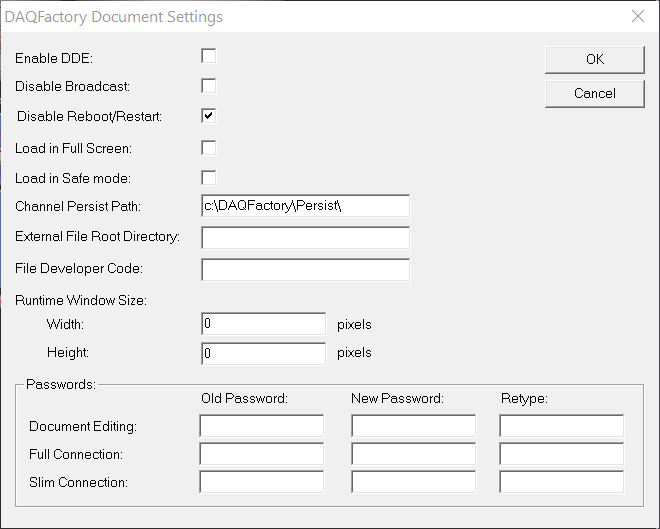Various document settings can be changed by selecting File-Document Settings from the main menu.

Enable DDE: DDE is a Windows mechanism for sharing data with another application running on your computer. You could use DDE for example, to fill cells in an Excel spreadsheet in real time. Unfortunately, acting as a DDE server requires more processor power and overhead. Because of this, by default, DDE is disabled. To enable DDE for this document, check the enable DDE box. DDE is described in further detail in the networking chapter.
Disable Broadcast: Broadcasting refers to the mechanism DAQFactory uses to transfer data in real time to other copies of DAQFactory running remotely. By checking this box, the internal network data server is disabled and no remote copies of DAQFactory can connect to this system. For security reasons, this is checked by default, so to use DAQFactory Networking, you must specifically uncheck this box. You will then need to save your document and restart to have the change take effect. We strongly recommend setting both a Full Connection and Slim Connection password as described below. This ensures that the data encryption used for communication uses a key that is unique to your application. If the password is not specified, the communication is encrypted with the same key as everyone else who leaves their password blank. The only time this would be safe would be when the system is on a completely stand alone network.
Disable Reboot / Restart: if you have broadcasting enabled and are connected over the Full data stream, you can remotely reboot or shutdown the remote system. This is useful in headless applications. Since these applications are rare, this is checked (i.e. disabled) by default. To enable this feature you will need to uncheck this box, save your document then restart.
Load in Full Screen: Checking this will cause this document to load in full screen mode instead of the standard mode with a window frame, menus, etc. It is usually better to instead use the system variable, system.FullScreen = 1, and an auto-start sequence script to do this. You can manually switch between full screen and non full screen by clicking View - Full Screen from the main menu, or hitting F4.
Load in Safe Mode: By checking this box, you can force this document to always open in safe mode. You can then start the acquisition and automation by selecting File-Leave Safe Mode.
Channel Persist Path: This allows you to change the directory where the channel persist files are stored. If you are only working on one document, then you probably don't need to change this. If, however, you are working with multiple documents with the possibility of the same channel names amongst them, you will probably want to set each document with its own persist path so they don't conflict. You can also change this value from script using the system.PersistPath variable.
External File Root Directory: when using the external file feature to keep parts of your document (such as sequences and pages) in external files, this parameter specifies the root directory that all paths are based off of. You should always specify a full directory (i.e. c:\myfiles\) here if using the external file feature.
File Developer Code: when using the external file feature, this code must match the Local Developer Code specified in the Preferences window for files to be saved externally. This is so that you don't accidently save external files on customer computers, just your development computer.
Runtime Window Size: The runtime version of DAQFactory does not have a menu, toolbar, workspace or other docking windows. It only has the page view. When the runtime engine loads this document, it will automatically size its window to the size given here in pixels if they are not zero. This keeps the runtime window from having a huge amount of white space when displayed on larger monitors. You can also use the window scaling features (for example window.autoscale = 1) to automatically scale your pages to the Window size and leave these values at 0, though in this case you will still have to tell the window what size your pages were designed for. See the section on DAQFactory Windows and Popups for more info.
Passwords:
There are three different passwords available. Each one is set by entering the current password (which defaults to blank) and then entering the new password twice. If you do not enter anything in these boxes, the password setting remains the same. Note that these passwords are not encrypted and are designed only as a deterrent. In cases where security is of grave concern, other methods should be employed. If you do not wish to require a password for a given event, set the password to blank.
Document Editing password: If specified, this password is required to open the document in any version of DAQFactory except in runtime mode. Note that the password cannot end with spaces.
Application: The document editing password allows you to create a document that you can distribute to anyone for use, but that cannot be edited even if they purchase a development copy of DAQFactory.
Full / Slim Connection: These passwords are required by a remote copy of DAQFactory to connect to the full or slim data stream of this document. See Networking for more information.
Application: If you do not want anyone to have access to your system remotely, but you still wish to have access, provide a password for both the slim and full stream. You can use the same password if you would like.
Application: If you want to share some data with other users, but keep them from seeing all the data put a password on the full connection, but leave the slim connection open, or better yet, make your slim connection password something simple and tell everyone it. This at least causes the data encryption to be unique to your application and protect it from hackers.